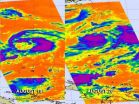(Press-News.org) Nanoparticles tailored to latch onto blood platelets rapidly create healthy clots and nearly double the survival rate in the vital first hour after injury, new research shows.
"We knew an injection of these nanoparticles stopped bleeding faster, but now we know the bleeding is stopped in time to increase survival following trauma," said Erin Lavik, a professor of biomedical engineering at Case Western Reserve University and leader of the effort.
The researchers are developing synthetic platelets that first responders and battlefield medics could carry with them to stabilize car crash or roadside bomb victims. An injection could slow or halt internal bleeding until the victim reaches a hospital and receives blood transfusions and surgery.
Lavik spoke about the latest breakthroughs in her research today at the American Chemical Society's annual meeting in Philadelphia.
Lavik and her colleagues began focusing on synthetic platelets after learning the military has no equivalent of a tourniquet, pressure dressing or other easily transportable technology to stem bleeding from internal injuries.
But as they explored possible applications, they recognized that the approach is widely needed beyond military conflict. Traumatic injury is the leading cause of death for people age 4 to 44, often overwhelming the body's natural blood-clotting process.
The platelet-like nanoparticles are made of biodegradable polymers used in devices already approved by the Food & Drug Administration for use in humans. They're designed to hone in on injuries after injection. Natural platelets, activated by injury, emit chemicals that bind natural platelets and the additional synthetics into a larger clot faster than natural platelets alone.
Tested on a lethal liver injury model in lab rats, the one-hour survival rate of the models injected with the nanoparticles was 80 percent. For control groups treated with saline alone the survival rate fell to 47 percent, while control groups receiving scrambled nanoparticles totaled just 40 percent. Among the three, the models treated with the platelet-like nanoparticles exhibited the least blood loss.
The researchers also found that the hybrid clots were as firm as natural clots. In additional testing, they found no complications following administration of the nanoparticles.
Earlier tests showed these synthetic platelets can cut bleeding time by as much as half and that, a week later, the rats showed no ill effects from the materials
The researchers include graduate students Andrew J. Shoffstall, Lydia M. Everhart and Margaret M. Lashof-Sullivan; research assistants Kristyn T. Atkins and Rebecca E. Groynom; undergraduate student Matt E. Varley; and administrative assistant Blaine Martin-Dow, all of Case Western Reserve. They are teamed with Robert S. Butler, of the Department of Quantitative Health Services at the Cleveland Clinic, and Jeffrey S. Ustin, assistant professor, Case Western Reserve University School of Medicine and member of the Department of General Surgery at the Cleveland Clinic.
They are continuing to test the platelets with other models of injury, working toward the best design and dosage for human use.
INFORMATION: END
The risk of dying from breast cancer was not related to high mammographic breast density in breast cancer patients, according to a study published August 20 in the Journal of the National Cancer Institute.
One of the strongest risk factors for non-familial breast cancer is elevated mammographic breast density. While women with elevated mammographic breast density have a higher risk of developing breast cancer, it is not established whether a higher density indicates a lower chance of survival in breast cancer patients.
In order to determine if higher mammographic breast ...
NASA's Terra and Aqua satellite have captured Hurricane Gordon over three days as it neared the Azores Islands in the eastern Atlantic Ocean. Gordon weakened to a tropical storm on August 20.
The Moderate Resolution Imaging Spectroradiometer, or MODIS, is an instrument that flies onboard NASA's Terra and Aqua satellites and provides high-resolution imagery to users. When NASA's Terra satellite flew over Gordon on August 17 at 9:30 a.m. EDT it was a tropical storm and did not have a visible eye. It was followed up by a fly over of NASA's Aqua satellite on August 18 at ...
The first evidence of a planet's destruction by its aging star has been discovered by an international team of astronomers. The evidence indicates that the missing planet was devoured as the star began expanding into a "red giant" -- the stellar equivalent of advanced age. "A similar fate may await the inner planets in our solar system, when the Sun becomes a red giant and expands all the way out to Earth's orbit some five-billion years from now," said Alexander Wolszczan, Evan Pugh Professor of Astronomy and Astrophysics at Penn State University, who is one of the members ...
Tropical Storm Bolaven was born over the weekend of August 18-19 in the western North Pacific, and NASA captured infrared satellite imagery of its birth and growth.
NASA's Aqua satellite has been monitoring the birth and progress of Tropical Storm Bolaven in the western North Pacific from Aug 19-20, 2012. The Atmospheric Infrared Sounder (AIRS) instrument has provided infrared satellite imagery that shows the development of colder thunderstorm cloud-top temperatures, that were indicative of strengthening storms. Tropical Storm Bolaven also took more of a rounded shape ...
Researchers have long studied infants' perceptions of safe and risky ground by observing their willingness to cross a visual cliff, a large drop-off covered with a solid glass surface. In crawling, infants grow more likely to avoid the apparent drop-off, leading researchers to conclude that they have a fear of heights. Now a new study has found that although infants learn to avoid the drop-off while crawling, this knowledge doesn't transfer to walking. This suggests that what infants learn is to perceive the limits of their ability to crawl or walk, not a generalized fear ...
Ethnic and political violence in the Middle East can increase violence in families, schools, and communities, which can in turn boost children's aggressiveness, especially among 8-year-olds. Those are the findings of a new study that examined children and their parents in the Middle East.
"The study has important implications for understanding how political struggles can spill over into the everyday lives of families and children, and suggests that intervention might be necessary in a number of different social areas to protect children from the adverse impacts of exposure ...
Young children in lower-income families who live in high-cost areas don't do as well academically as their counterparts in low-cost areas, according to a new study.
The study, by researchers at Child Trends and the University of California (UCLA), appears in the journal Child Development.
"Among families with incomes below 300 percent of the federal poverty threshold—that's below $66,339 for a family of four—living in a region with a higher cost of living was related to lower academic achievement in first grade," according to Nina Chien, a research scientist with Child ...
Regardless of how much a high school student generally studies each day, if that student sacrifices sleep in order to study more than usual, he or she is more likely to have academic problems the following day. Because students tend to increasingly sacrifice sleep time for studying in the latter years of high school, this negative dynamic becomes more and more prevalent over time.
Those are the findings of a new longitudinal study that focused on daily and yearly variations of students who sacrifice sleep to study. The research was conducted at the University of California, ...
It's thought that children grow increasingly distant and independent from their parents during their teen years. But a new longitudinal study has found that spending time with parents is important to teens' well-being.
The study, conducted at the Pennsylvania State University, appears in the journal Child Development.
Researchers studied whether the stereotype of teens growing apart from their parents and spending less time with them captured the everyday experiences of families by examining changes in the amount of time youths spent with their parents from early to ...
ANN ARBOR, Mich.---Children exposed to ethnic and political violence in the Middle East are more aggressive than other children, a new study shows. And the younger children are, the more strongly they are affected, in a "chain of violence" that goes from political and ethnic strife, to violence in communities, schools, and families, and ends with their own aggressive behavior.
"Our results have important implications for understanding how political struggles spill over into the everyday lives of families and children," says psychologist Paul Boxer, lead author of the ...


